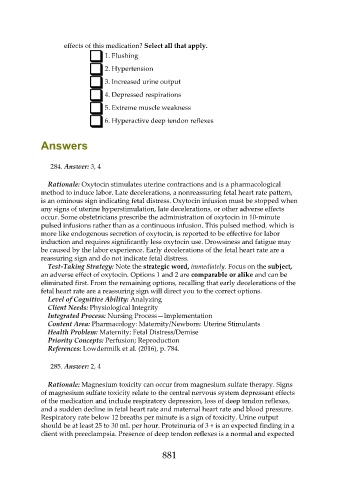Page 881 - Saunders Comprehensive Review For NCLEX-RN
P. 881
effects of this medication? Select all that apply.
1. Flushing
2. Hypertension
3. Increased urine output
4. Depressed respirations
5. Extreme muscle weakness
6. Hyperactive deep tendon reflexes
Answers
284. Answer: 3, 4
Rationale: Oxytocin stimulates uterine contractions and is a pharmacological
method to induce labor. Late decelerations, a nonreassuring fetal heart rate pattern,
is an ominous sign indicating fetal distress. Oxytocin infusion must be stopped when
any signs of uterine hyperstimulation, late decelerations, or other adverse effects
occur. Some obstetricians prescribe the administration of oxytocin in 10-minute
pulsed infusions rather than as a continuous infusion. This pulsed method, which is
more like endogenous secretion of oxytocin, is reported to be effective for labor
induction and requires significantly less oxytocin use. Drowsiness and fatigue may
be caused by the labor experience. Early decelerations of the fetal heart rate are a
reassuring sign and do not indicate fetal distress.
Test-Taking Strategy: Note the strategic word, immediately. Focus on the subject,
an adverse effect of oxytocin. Options 1 and 2 are comparable or alike and can be
eliminated first. From the remaining options, recalling that early decelerations of the
fetal heart rate are a reassuring sign will direct you to the correct options.
Level of Cognitive Ability: Analyzing
Client Needs: Physiological Integrity
Integrated Process: Nursing Process—Implementation
Content Area: Pharmacology: Maternity/Newborn: Uterine Stimulants
Health Problem: Maternity: Fetal Distress/Demise
Priority Concepts: Perfusion; Reproduction
References: Lowdermilk et al. (2016), p. 784.
285. Answer: 2, 4
Rationale: Magnesium toxicity can occur from magnesium sulfate therapy. Signs
of magnesium sulfate toxicity relate to the central nervous system depressant effects
of the medication and include respiratory depression, loss of deep tendon reflexes,
and a sudden decline in fetal heart rate and maternal heart rate and blood pressure.
Respiratory rate below 12 breaths per minute is a sign of toxicity. Urine output
should be at least 25 to 30 mL per hour. Proteinuria of 3 + is an expected finding in a
client with preeclampsia. Presence of deep tendon reflexes is a normal and expected
881

